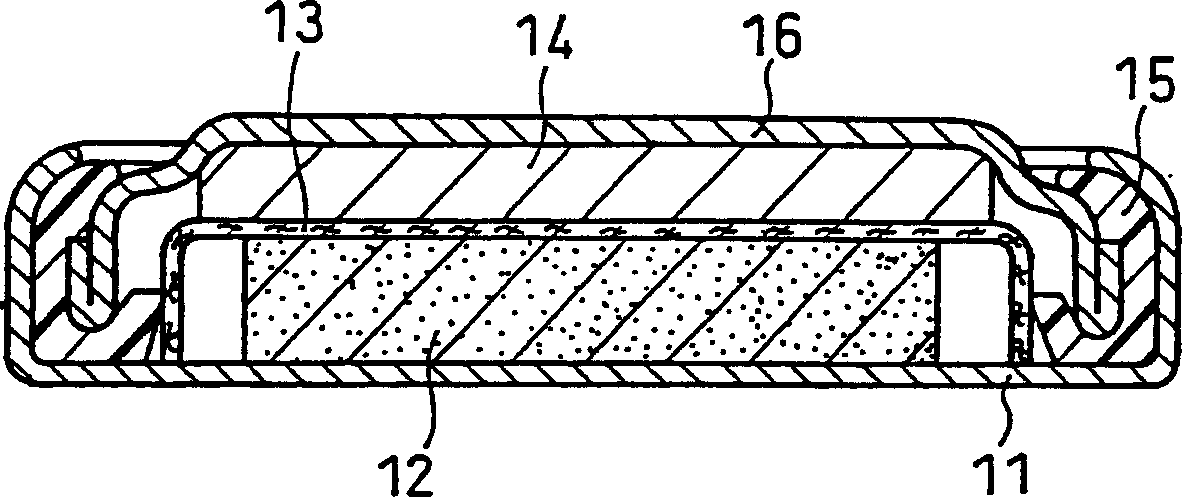Negative electrode for non-aqueous electrolyte secondary battery, producing method therefor, and non-aqueous electrolyte secondary battery
A non-aqueous electrolyte and secondary battery technology, applied in the direction of secondary batteries, battery electrodes, active material electrodes, etc., can solve the problems of reduced cycle characteristics and storage characteristics, side effects of positive active materials, and difficulty in maintaining adhesion functions, etc., to achieve Effects of high energy density, excellent adhesion and heat resistance, and excellent electron conductivity
- Summary
- Abstract
- Description
- Claims
- Application Information
AI Technical Summary
Problems solved by technology
Method used
Image
Examples
Embodiment 1
[0067] (1) Preparation of negative electrode active material
[0068] Ti powder (manufactured by Kojundo Chemical Lab. Co., Ltd., 99.99% purity, particle size below 20 μm) and Si powder (manufactured by Kanto Chemical Co., Inc., 99.99% purity, particle size less than 20 μm), so that the proportion of the Si phase, that is, the phase A in the negative electrode active material particle, was 30% by weight.
[0069] The mixed powder was placed in a vibratory mill container, and stainless steel balls (2 cm in diameter) were further placed so that the balls occupied 70% by volume of the container capacity. After evacuating the inside of the container, the inside of the container was replaced with Ar (manufactured by Nippon Sanso Corporation, 99.999% purity) until the inside pressure of the container became 1 atm. Then, mechanical alloying was performed for 40 hours while applying vibration of 60 Hz to obtain a Ti—Si alloy.
[0070] As a result of performing X-ray diffraction meas...
Embodiment 2-5
[0106] In these examples, in the case where polyimide and polyacrylic acid were used for the negative electrode binder, the heating temperature of negative electrode pellets containing polyamic acid as a polyimide precursor was examined.
[0107] Coin cells were prepared in the same manner as in Example 1 except that the heating temperature of the negative electrode pellets was changed to the temperatures shown in Table 2, and then evaluated. Together with the results of Example 1, the evaluation results are shown in Table 2.
[0108] Negative electrode pellets
(℃)
imidization
Rate(%)
initial capacity
(mAh)
Low temperature capacity
(%)
Cycle capacity
(%)
Example 2
150
reserve
20
6.5
85
84
Example 3
200
reserve
80
6.5
85
90
Example 1
...
Embodiment 6-10
[0114] In these examples, when polyimide and polyacrylic acid were used as the binder in the preparation of the negative electrode, the contents of the binder materials (polyamic acid and polyacrylic acid) in the negative electrode mixture were examined.
[0115] A button cell was prepared in the same manner as in Example 1, except that in the negative electrode mixture, the content of the binder was variously changed per 100 parts by weight of the negative active material, as shown in Table 3, but the binder material was not changed The mixing ratio of polyamic acid and polyacrylic acid was evaluated.
[0116] Together with the results of Example 1, the evaluation results are shown in Table 3.
[0117] Binder in negative electrode mixture
Material content (parts by weight)
initial capacity
(mAh)
cycle capacity retention
(%)
Example 6
0.2
6.5
86
Example 7
0.5
6.5
93
Example 8
5.0 ...
PUM
| Property | Measurement | Unit |
|---|---|---|
| melting point | aaaaa | aaaaa |
| thickness | aaaaa | aaaaa |
| thickness | aaaaa | aaaaa |
Abstract
Description
Claims
Application Information
 Login to View More
Login to View More - R&D
- Intellectual Property
- Life Sciences
- Materials
- Tech Scout
- Unparalleled Data Quality
- Higher Quality Content
- 60% Fewer Hallucinations
Browse by: Latest US Patents, China's latest patents, Technical Efficacy Thesaurus, Application Domain, Technology Topic, Popular Technical Reports.
© 2025 PatSnap. All rights reserved.Legal|Privacy policy|Modern Slavery Act Transparency Statement|Sitemap|About US| Contact US: help@patsnap.com

